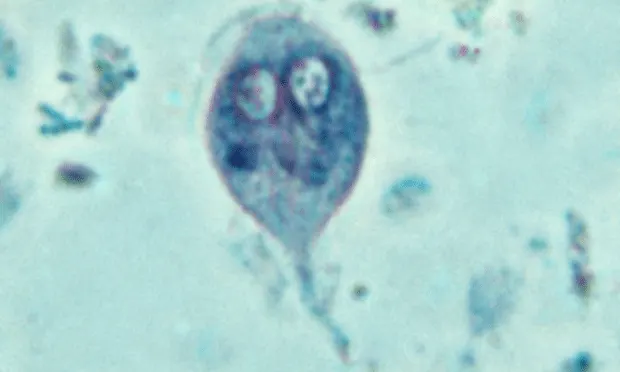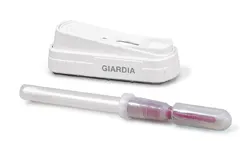Idexx Snap: Giardia for Dogs & Cats

The presence of Giardia cysts in the feces of dogs and cats is fairly common. Depending on the population sampled, the prevalence in dogs and cats can vary from 0% to more than 50%. Not all infected animals have clinical signs; some will have only mild or transitory diarrhea, and some may have severe and chronic diarrhea. Regardless, both dogs and cats are routinely infected by this flagellated protozoan (Figure 1, above).
IndicationsIn the recent past, the taxonomy of Giardia was ruled by those who believed that nearly all Giardia species in domestic animals were the same; this species was called Giardia intestinalis. However, current molecular epidemiologic assays have indicated that dogs, cats, and humans each essentially have their own set, or assemblage, of organisms. Some crossover between the organisms in cats and dogs and other hosts does occur, but this is relatively uncommon. In the old nomenclature, we would have called the species in dogs Giardia canis, in cats Giardia felis, and in humans Giardia lamblia. Veterinarians should note two important points. First, the zoonotic threat of Giardia is not considered to be as great as it was several years ago. Second, the antigen from which the new SNAP Giardia test for dogs and cats has been developed should detect any of the Giardia assemblages. Thus, the test should be robust and accurate in a cat or a dog regardless of the original source of infection.
This protozoan parasite has two forms: the motile flagellate stage (i.e., the trophozoite) and the nonmotile transmission stage (i.e., the cyst). The cyst is the stage most commonly found in samples from animals with formed feces. Trophozoites are sometimes found in semiformed or liquid feces and are best visualized in direct fecal smears diluted in saline. Trophozoites are harder to find than cysts, especially when present in small numbers.

How It WorksThe IDEXX SNAP Giardia test (Figure 2) detects soluble antigen found in the feces of the infected animal. A fresh fecal sample is collected on a swab at the end of a hollow straw connected to a small reagent bulb. The bulb contains an antibody to the soluble Giardia antigen; this antibody is bound to a peroxidase conjugate. At the time of use, the contents of the bulb are released by breaking the plastic valve stem at the end of the straw. The conjugated antibody solution is then mixed with the fecal sample by squeezing the plastic bulb and forcing the solution over and through the fecal matter held by the swab in a small tube. Then, 5 drops of the liquid containing some fecal debris, the reagent solution, and the antigen (if present) bound to the antibody conjugate is pipetted into the well of the test device. The solution then flows across the membrane in the device.
Figure 2. The IDEXX SNAP Giardia test for dogs and cats, showing the device itself as well as the swab, the hollow straw, and the small reagent bulb.
If the soluble antigen-antibody complex is present in the solution, it is "captured" by a second antibody that is immobilized on a spot on the membrane in the device. An "activate" circle on the device will change color, indicating that the solution placed in the well has flowed an appropriate distance on the membrane in the device. This takes about 30 to 60 seconds, after which it is time to "snap" the device. When the device is "snapped," a substrate reagent flows across the membrane, causing the antigen-antibody conjugate to become colored if the antigen was captured by the antibody on the test membrane. Thus, a positive sample produces a small blue dot on the membrane. The test includes a positive control spot that verifies that the reagents are working properly and a negative control spot that controls for false-positive results.
AdvantagesThe test can be done in the clinic at the side of the patient, quickly confirms a suspected case of giardiasis, and requires neither an ultraviolet microscope nor a trained microscopist for detection. Because the test works on soluble antigen, it should be able to detect cysts or trophozoites and should work in animals showing no signs (annual checkup) as well as those with diarrhea. The test has shown high sensitivity and specificity when compared with in-house testing with a fluorescein-labeled antibody and ultraviolet microscopy. Preliminary data where the test has been compared to zinc sulfate centrifugation has indicated that there is a good correlation between results with these two tests.
DisadvantagesAs with all antigen detection tests, when the pathogen is often easily visible, discrepancies can be observed in the field. This does not happen with tests for viruses or heartworm in amicrofilaremic dogs. Veterinarians tend to be cautious and will run comparisons in house, and multiple discrepancies would probably cause them to stop running the test. Another potential problem is that the test makes it easier to verify the presence of an infection, thus making it easier to find infections in animals after as well as before treatment. Thus, until we are better at interpreting posttreatment results, there may be an apparent increase in the number of cases that are refractory to treatment.
Facilitating the diagnosis of infection should also aid in improving therapy for Giardia infection by determining whether treatment has been successful. Treatment success is often measured empirically by resolution of signs without verification that the infection has cleared. As the SNAP Giardia test is used more and more, it should be possible to ascertain the success of different treatment methods and to determine which therapies are truly successful.
Economic ImpactEach testing system costs $7.
IDEXX SNAP GIARDIA FOR DOGS AND CATS • Dwight D. Bowman
Suggested Reading
Endoparasites in dogs and cats in Germany 1999-2002. Barutzki D, Schaper R. Parasitol Res 90(Suppl 3):S148-S150, 2003.Evaluation of fenbendazole for treatment of Giardia infection in cats concurrently infected with Cryptosporidium parvum. Keith CL, Radecki SV, Lappin MR. Am J Vet Res 64:1027-1029, 2003.Gastrointestinal parasites of domestic cats in Perth, Western Australia. McGlade TR, Robertson ID, Elliot AD, et al. Vet Parasitol 117:251-262, 2003.High prevalence of Giardia detected in cats by PCR. McGlade TR, Robertson ID, Elliot AD, et al. Vet Parasitol 110:197-205, 2002.Survey of clinic practices and testing for diagnosis of Giardia infections in dogs and cats. Groat R. ACVIM Proc, 2002.Tools to diagnose feline giardiasis. Lappin MR, Jensen WA, Taton Allen G, et al. Veterinary Practice News 14:10, 26, 2002.